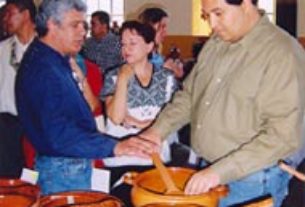[” Rompe – Cabeza ” (ROM-pe ca -BAY-sa, literally “head breaker”), is a term that Mexicans apply to all puzzles, from crosswords to mazes.]
As you stroll through the Alameda, the vest-pocket park in front of the Cathedral plaza in Oaxaca, around 7:00 in the evening, keep an eye out for Ignacio Cervantes. He’s the elderly, white-goatee’d guy standing near the corner, next to a sort of Cross of Lorraine construction with a bunch of wire thingees dangling from it. He’s not hard to spot. Actually, he sort of glows. His spirit seems lighter than those around him, and all the more so if he has an audience.
Ignacio sells puzzles. He makes them and he demonstrates them. They are simple puzzles in construct, composed entirely of bent galvanized wire. They all have a simple goal: separate two intertwined pieces of wire. Some are quite easy, some are medium tough, and some can lead otherwise rational persons to commit homicide.
Ignacio learned the puzzle business from his father, as a youth in Mexico City. Born in 1922, he was the youngest of four brothers, and the last of them to ply his trade. He has one son left at home. “My son was never interested in the puzzles,” he said. “I have heard that a nephew who lives in Juarez makes them, and sells them on the other side (the U.S.), but I have never met him.” His oldest grandson says that he wants to be a puzzle maker when he grows up, but Ignacio doubts that his interest will survive his teen age years.
When his father retired from the trade, he had around 25 designs that he manufactured. Ignacio now has 68 designs including his father’s. He keeps them in a book he started in 1963. He insists that all his own designs are original, even though some of them are very much like others uncovered in ancient Chinese texts. Art, he points out, tends toward the universal, and coincidental duplication should be no surprise.
We were sitting in his workshop, and the day was very hot. Oaxaca just before the rainy season when the sun is brutal and the shade a blessing. Constructed of wood and bamboo, with a thatched roof and a bare floor, it consists of a small table and a couple of chairs. His tools are a half-dozen differently shaped pairs of pliers, and a matrix which he made himself for winding wire into spirals. “You couldn’t buy such a thing. I am not sure you can buy one now. We Mexicans have had to be very good at making the tools we need to do our work.”
Ignacio proudly showed us some books of puzzles and puzzle designs, in English and in Chinese, compiled and distributed by Wei Zhang and her husband Peter Rasmussen of Berkeley. “They sent me these,” he said. “They wanted me to know about other puzzles and puzzle makers.” He points out several designs like his own in the Chinese book. “You see? These are ideas that are eternal. They come to people everywhere.” I asked him if he knew of others doing the same work in Mexico. He said he did not know them by name, but he had heard rumors of others. “There are certainly others in Guadalajara, Mexico City, and other large cities. It is natural that there would be.”
I asked Ignacio if he had done much traveling in his life. “Mucho.” He has been in every state of Mexico save three, and in many states “on the other side”. For much of his life, travel was a primary factor of his existence. As well as making his puzzles and selling them, he has been an itinerant buttons-and-bows salesman, a vocation that took him to villages so remote that “they didn’t know whether to welcome me or to kill me”, where no-one knew how to count money. “They would bring me a sack with money and tell me to take what I had coming. It was good for them that I was honest.”
As well, Ignacio would buy pottery and other local artesania for resale in the bigger towns. “If my VW van could get there, I would go.” For thirty years, starting in the mid-forties, Ignacio crossed over to work the crops in almost every state west of the Mississippi river. “The money was wonderful, but not the life. I have never had any desire to settle down in the U.S.” He has two sons in the States but he can’t go there to visit any more. “They made it so difficult to cross, I have given up”. When he worked the crops, and when he traveled in Mexico, he also sold his puzzles. “They used to sell for one peso each. That was enough to pay the bills in those days.”
In 1962, he married a woman from Oaxaca, and while he traveled she stayed home and took care of their children. Now he lives with his youngest son, his wife, and their three children on a property he has owned for more than thirty years. “Sometimes I think how much I would like to see the rest of the world again. I know that I can support myself by making and selling my puzzles. It only takes me five minutes to make one. The profits are good. It would be interesting to travel again. But then I think of my grandchildren, and how much I am enjoying watching them grow up, and I decide to stay home.”
That night, down near the Zócalo, Ignacio is plying his trade. About ten people have gathered around him as he very slowly demonstrates how to separate the wires of a particularly tricky puzzle. Once, twice, three times he unwinds and then rewinds the puzzle before some brave soul says “I can do that.” Patiently, he watches as the guy tries over and over to do it. Eventually, the customer gives it back. “I can’t do it.” He demonstrates it again and offers it to him. This time he figures it out, and a sale is made. “This is where I need my patience”, Ignacio says. “It’s a good thing that I like dealing with people. Besides, I meet so many interesting folks.”
I ask him if he ever thinks of retirement. “To do what? Sit around all day and do nothing? No, no, I am much too young (76) to do that. Besides, if I don’t do this, who will?”


